Who We Are
"A Slightly Different Kind of Publisher"
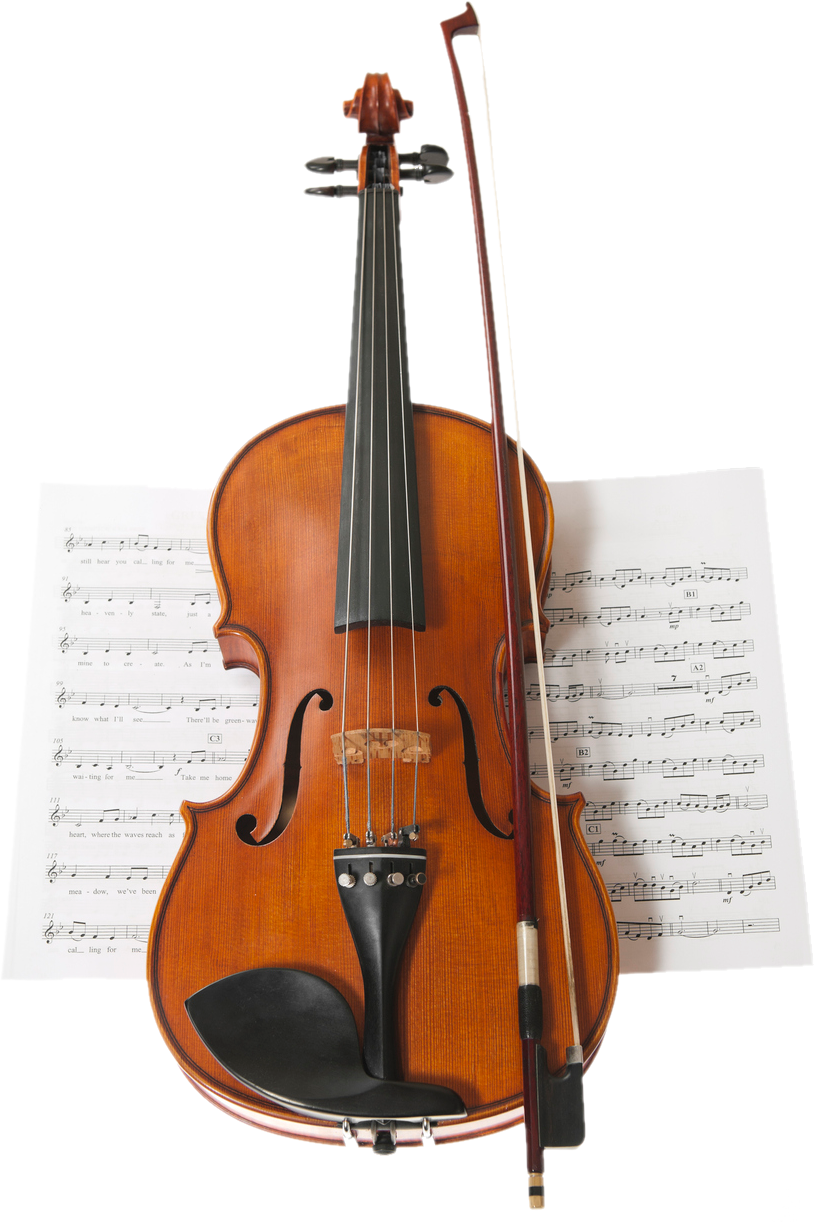
Our Catalogue
Read our Sales Policies Here

Allegretto (from Piano Sonata Op. 27 #2) – Ludwig van Beethoven
Key: D Major
Meter: Duple Compound (3/4). Piano Sonata Op. 27 #2 is more commonly known as “Moonlight Sonata.” This piece is a transcription of the opening section of the second movement of this famous work. Incorporated into this setting are sudden dynamic changes, tied rhythms (most across the bar line) and double stops for ‘celli. Many opportunities to experiment with different bowings exist. Done one beat to the bar, Allegretto can present some rhythmic challenges. Dynamics are from the piano original. Medium advanced.

Ancient Voices of Wupatki
Key: E Aeolian
Meter: Duple Simple (4/4). This work uses only quarter notes & quarter rests so it is potentially playable by a string orchestra very early in their instruction. The modal melody together with ostinato accompaniment patterns are meant to convey the daily life and work of the ancient people who inhabited the area around Sunset Crater (Arizona) over 1500 years ago. Violins alternate melodic responsibilities with the violas & ‘celli. Accompaniment patterns include a rest on the downbeat of the bar. The part for vibraphone can be done by a high school percussion student, on a synthesizer, or by students on tone chimes. Piano part is included but is not necessary for performance. Very easy.
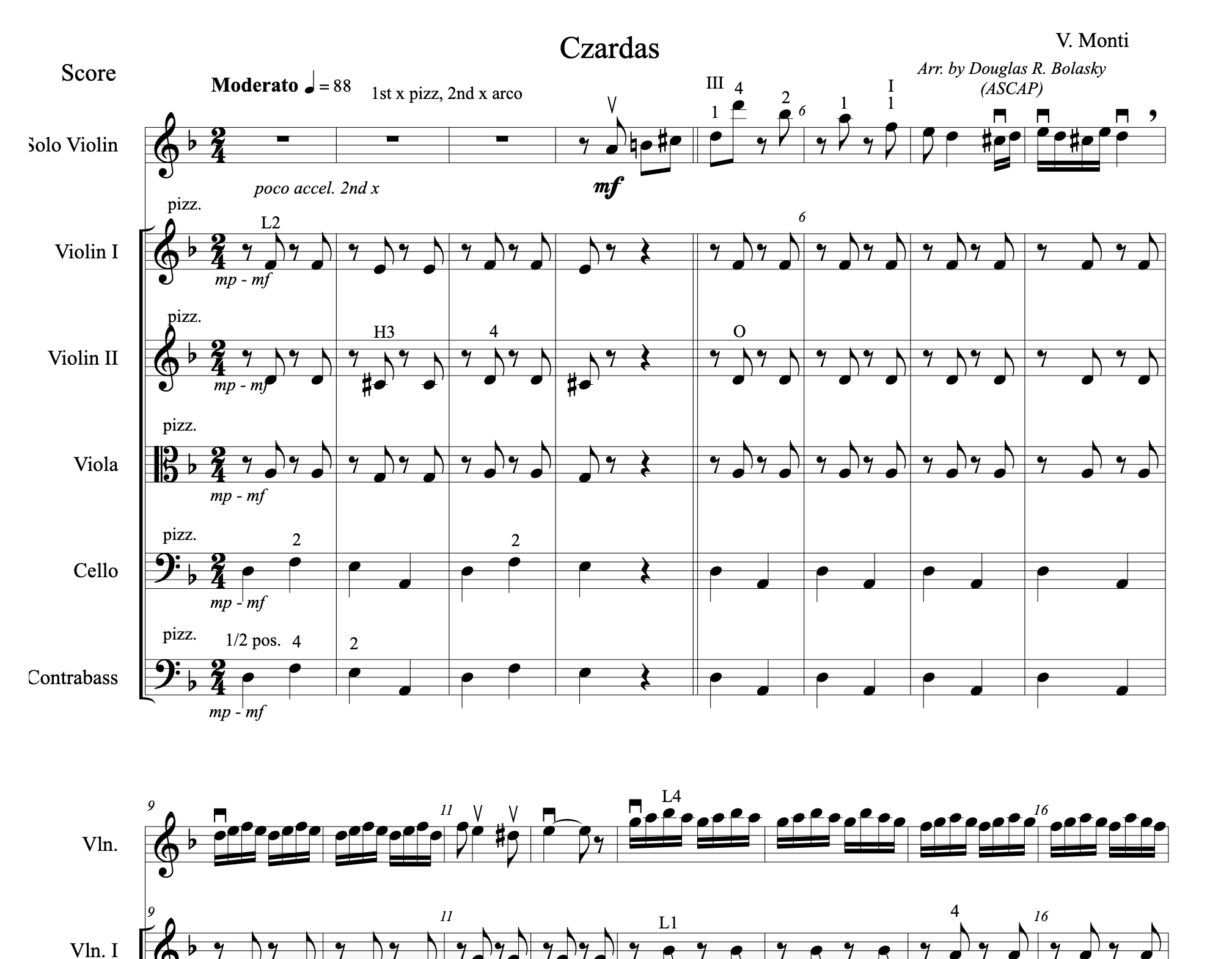
Czardas – Vittorio Monti
Key: Various
Meter: Duple Simple (2/4). Adding a little bit of Hollywood “show-biz” to a concert program is always a good idea, so if you have an outstanding violinist in your orchestra, consider showcasing them in an adaptation of this perennial favorite, composed in 1904. Monti’s fame rests chiefly on this piece, which can be found in the repertoire of almost any gypsy orchestra. Starting slowly and deliberately, the tempo increases as the melody passes through d minor, e minor, f minor and f# minor until climaxing in a firestorm of speed in g minor. An inverted statement of the theme (not in the original) also appears. You will have no problem getting your audience to clap along, adding to the excitement and enjoyment of this work while challenging your orchestra with the changes in tonality. Orchestra – medium. Solo violin – advanced.
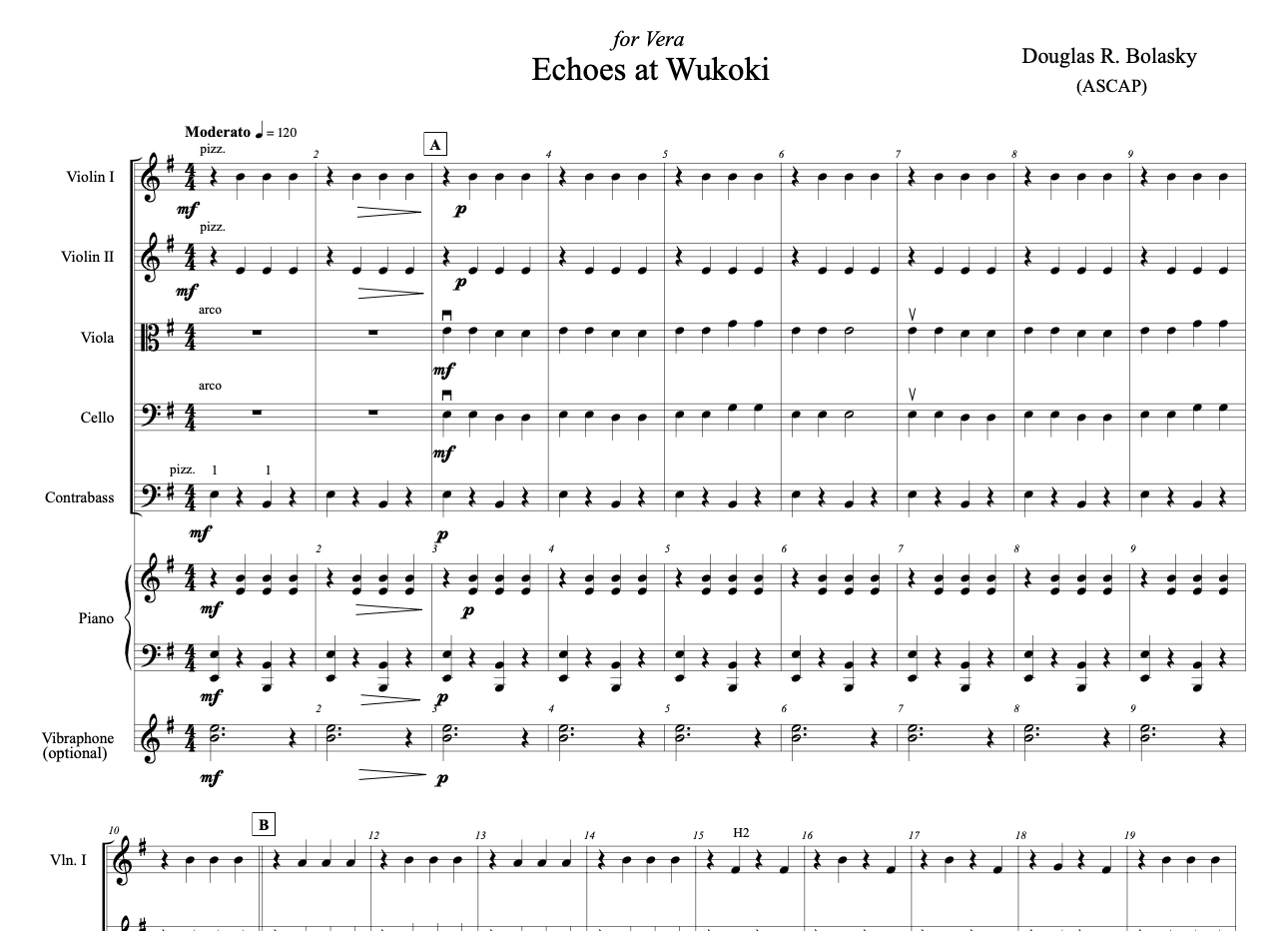
Echoes at Wukoki
Key: E Aeolian
Meter: Duple Simple (4/4). This is the companion piece to “Ancient Voices” SO-102E above,using the same structure and the same harmonic and melodic material. Half notes have been added to the rhythms along with changing dynamics. The relative ease of the piece for older students opens up the opportunity to emphasize the expressive elements. Vibraphone part and optional piano part are also included. Easy.
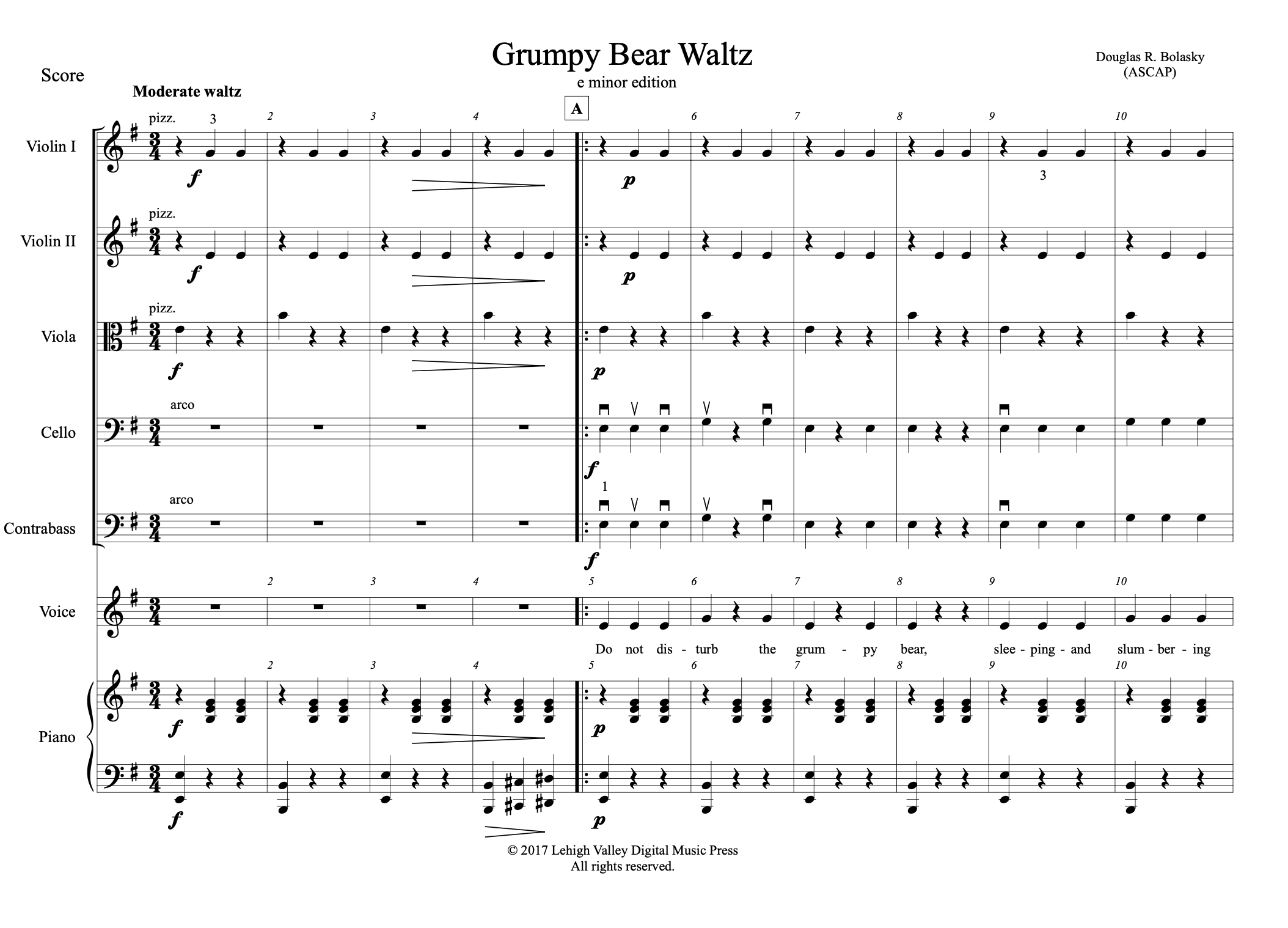
Grumpy Bear Waltz in E
Key: E Melodic Minor
Meter: Triple Simple (3/4). So when do the basses get to play the melody? Answer – in THIS piece! Together with the cellos, “Grumpy Bear Waltz” casts the basses in a melodic role, plus an included optional voice part for audience participation. While piano is not necessary for most of the very easy pieces in this catalogue, the piano here covers the chromatics (A#, C# & D#) as they are found in none of the string parts. Very easy. Use catalogue #SO-105E
Grumpy Bear Waltz is also available in d melodic minor. This key provides your students with the chance to use the lowered 3rd degree of the scale and the lowered 2nd finger for violins & viola and 2nd finger for cellos & basses. Like the original in E minor, piano is required for the chromatics. Use catalogue #SO-105D
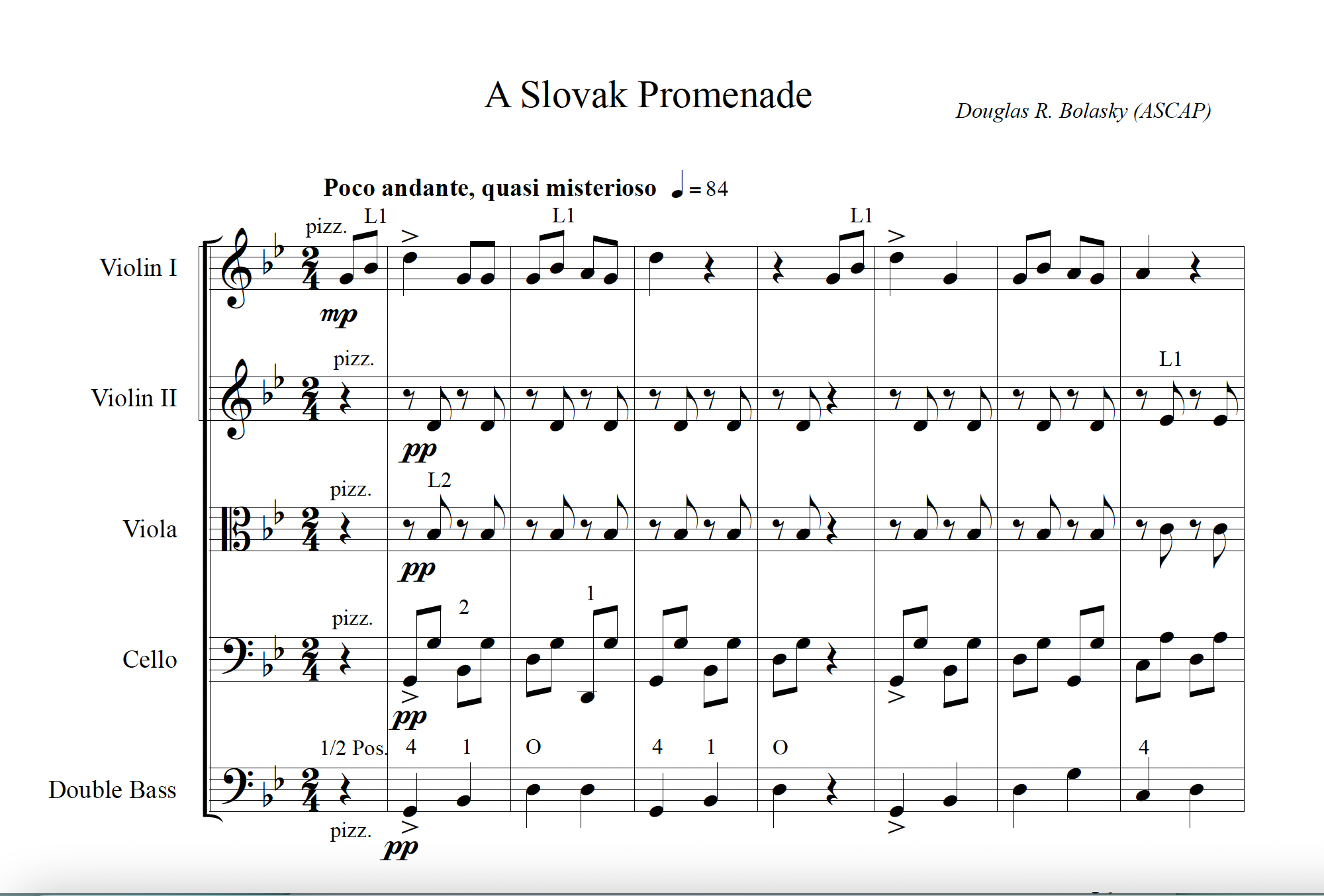
A Slovak Promenade
Key: G Minor, Bb Major, C Major
Meter: Triple Simple. “A Slovak Promenade” is a traditional composition with thematic material influenced by eastern European melodic characteristics. All parts have melodic responsibilities and each of the sections in this clear-cut rondo form are marked by key changes and decidedly contrasting materials, coupled with varying “walking” tempi. Edited with suggested bowings and fingerings. Advanced.
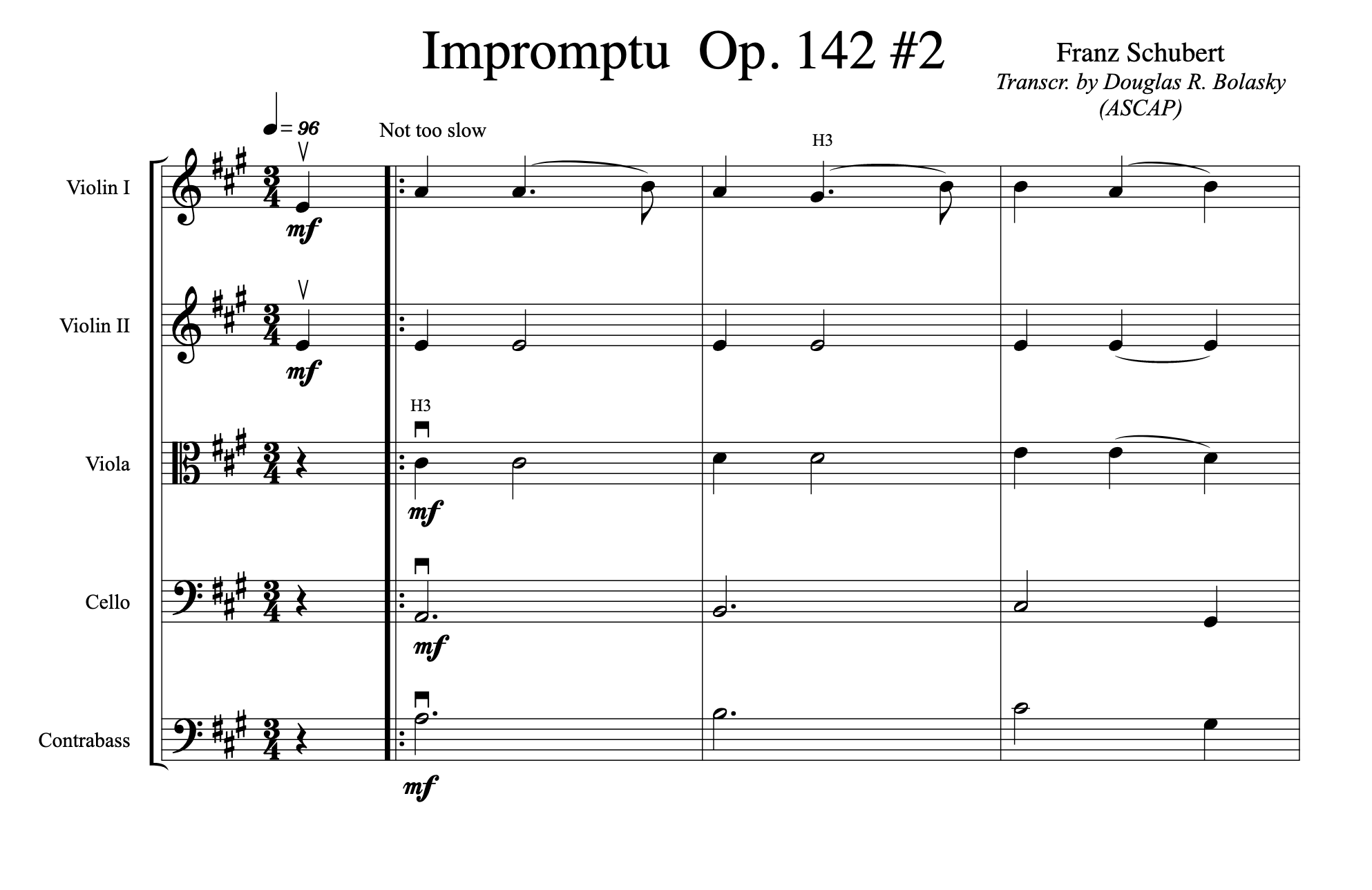
Impromptu Op. 142 #2
Key: A Major
Meter: Triple Simple (3/4). Transcribed in the original key from the piano work, this is an excellent and accessible introduction to A major without placing undue technical demands on the players. The ternary form is best amplified by use of a faster tempo in the middle section; more mature groups can work in additional application of rubato at the discretion of the conductor. Use of the upper half of the bow on repeated statements of the main theme help lend a transparent quality appropriate for the composer and in keeping with the piano original. Medium to medium-advanced. Use catalogue #SO-107A.
Impromptu Op. 142 #2 is also available transcribed in G major to ease some of the pitch issues presented by the original key. The easier key will allow younger orchestras to explore all of the expressive elements described in the narrative for the original transcription. Medium. Use catalogue #SO-107G.
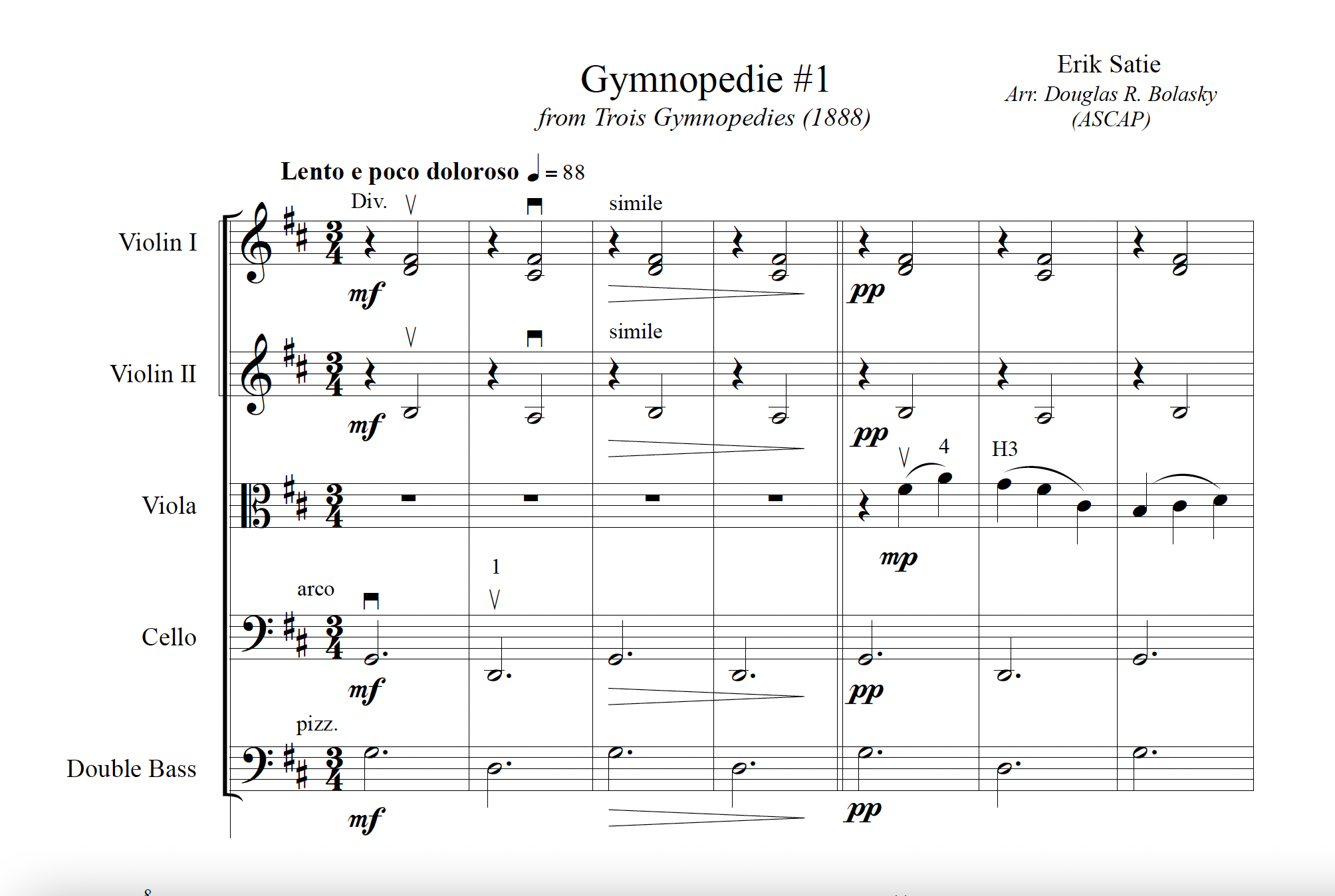
Gymnopedie #1
Key: D Major
Meter: Triple Simple (3/4) Composed by Erik Satie and completed in 1888, Trois Gymnopedies was originally a suite of three short piano works. This setting of Gymnopedie #1 entrusts the opening melodic line to the viola section, then passed to the violins. Passages in octaves provides opportunities for your string players to learn how to listen and play in tune across the orchestra with abundant chromatics demanding accurate finger placement. This arrangement is playable completely in 1st position with the exception of 6 bars in the cello part in octaves with Violin I. Edits include suggested bowings. Medium. Use catalogue #SO-121D.
For directors wishing to program this piece but whose cellists are not yet ready to shift, a second edition of Gymnopedie #1 is available. Also in D major, the Violin I’s are doubled in the final melodic phrase by the violas instead of the cellos. ALL parts are playable in 1st position. Use catalogue #SO-121D-EZ1
For advanced ensembles or the teacher wishing to challenge their orchestra to “get out of the D major rut,” Gymnopedie #1 will be available soon in the key of E major. Contact us at info@lvdmp.com for an update. Catalogue #S0-121E.
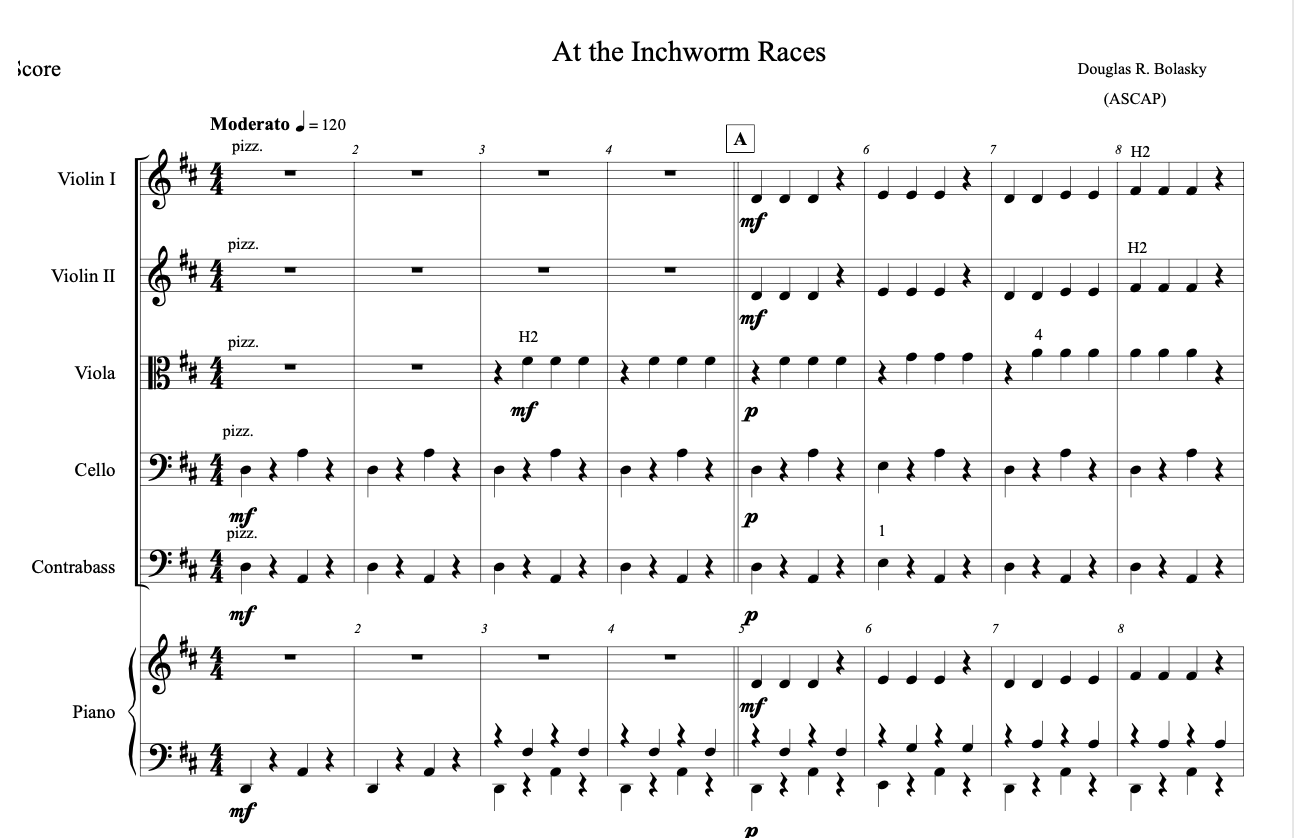
At the Inchworm Races
Key: D Major
Meter: Duple Simple (4/4). The title comes from the nature of the melody; starting, stopping, and “inching” its way up the scale from open D. “Inchworm Races” utilizes only quarter notes & quarter rests, making it very accessible for even the youngest of orchestras. Perhaps the biggest challenge may be getting students to rest on count 1 of the bar! Includes optional piano. Very easy.
Now available in G Major! Same as the original ‘Inchworm Races’ except played on the G & D strings. Contact us at info@lvdmp.com for instructions to order the G Major edition
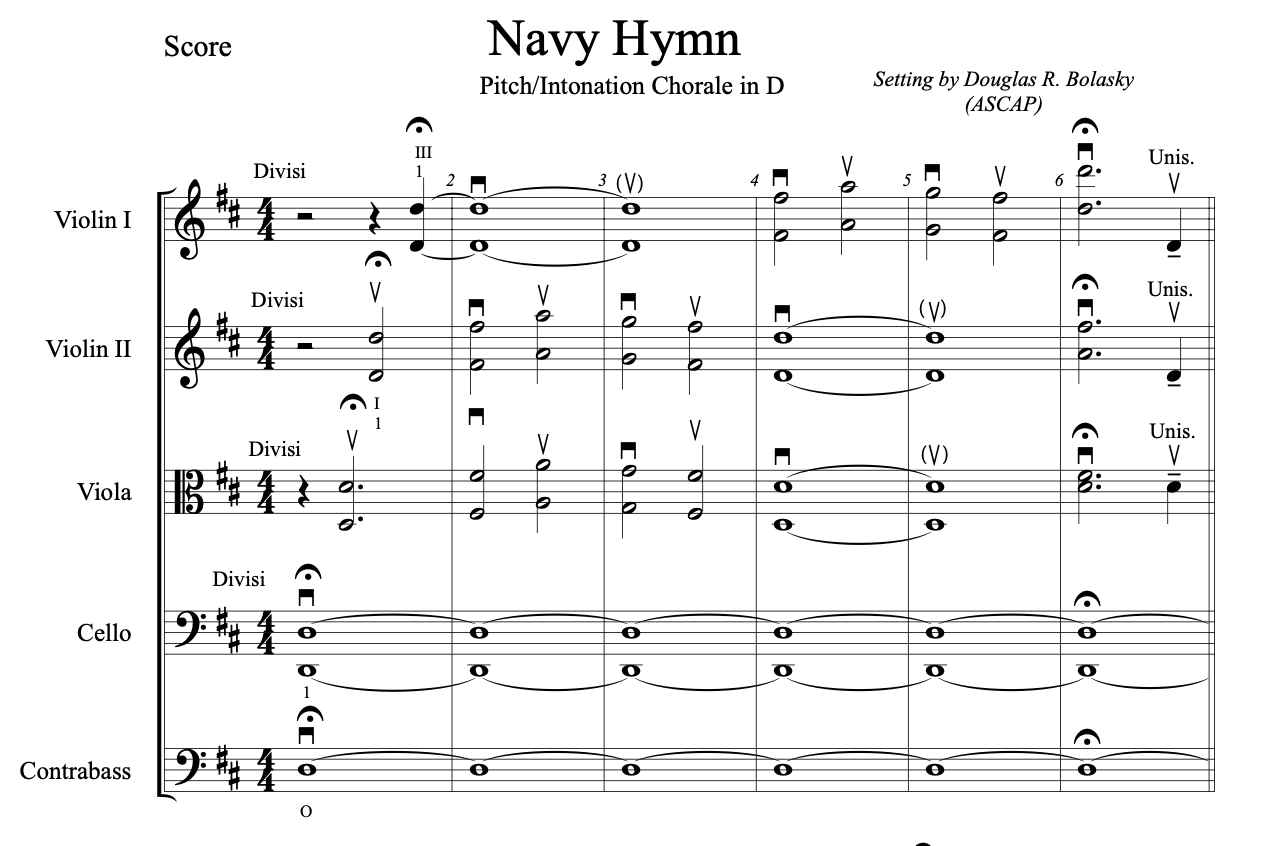
Navy Hymn Chorale
Key: D Major
Meter: Duple Simple. Playing successfully in tune in orchestra depends to a great degree on finger placement, although students need to know what they should be hearing first, then adjust pitch. The opening of this warm-up chorale is designed to do just that. Starting with tonic in unison and octaves, violins & violas progress through a mi-sol-fa-mi pattern against tonic pedal in low strings. It is useful to have the orchestra vocalize this pattern as well. The Navy Hymn itself is then presented in a mild reharmonization that is sprinkled with chromatics for all parts. Bowing indications are minimal; the conductor may insert those they desire. Dynamics have been omitted to allow the creative conductor to change dynamics in order to encourage the orchestra to watch. Additional editions of this chorale in other keys are in preparation – email info@lvdmp.com for specifics. Medium.
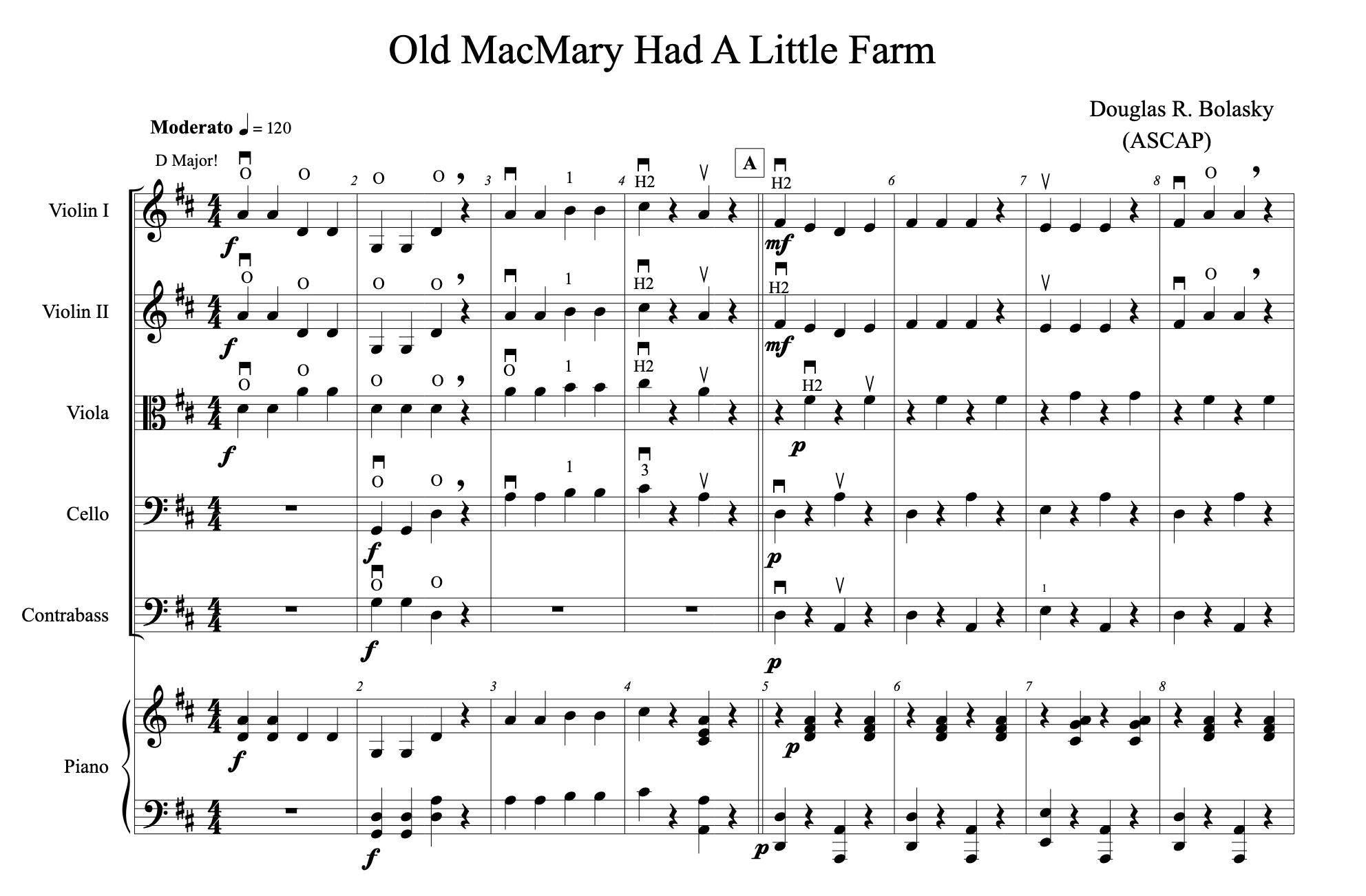
Old McMary Had a Little Farm
Key: D Major & G Major
Meter: Duple Simple (4/4). Using only quarter notes and quarter rests, this setting of two well-known childhood songs will be a snap to prepare. Beginning in D major, introduce your orchestra to change of key signatures (“B” section – Old MacDonald theme is in G) as well as introducing the violins, violas & ‘cellos to resting on counts 1 & 3. Add bowing patterns of your choosing or incorporate pizzicato. Includes optional piano. Very easy.
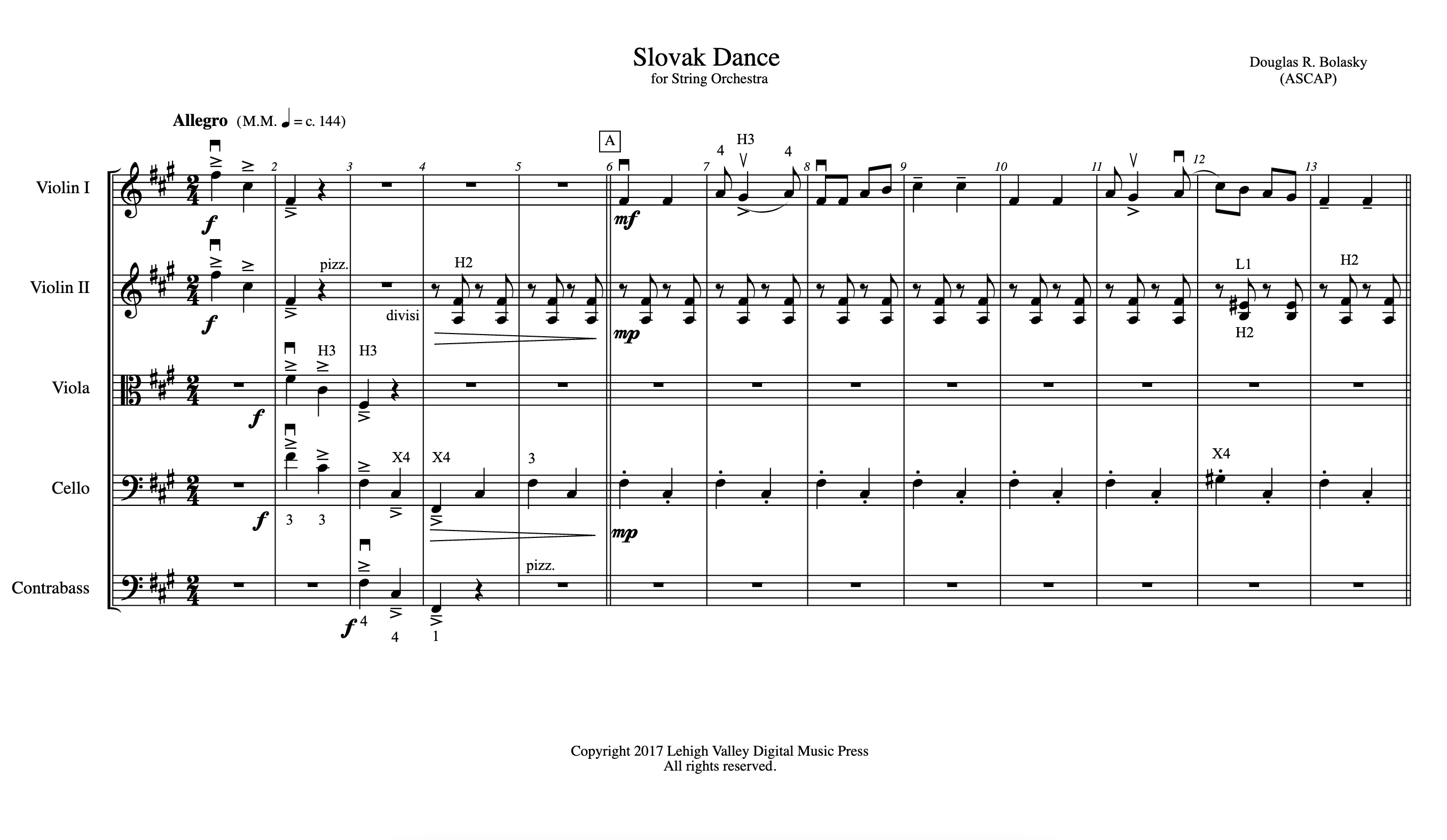
Slovak Dance
Key: f# minor, D Major & g minor
Meter: Duple Simple (2/4). The main point of this work is to provide something fun to play but yet is accessible while exploring the rarely-encountered key of f# minor. All sections get assigned to melodic roles throughout the work and the final modulation to g minor heightens the excitement as the piece comes to a close. Use a good brisk tempo to open the piece, then accelerando to as fast as your orchestra can play it well! Medium.
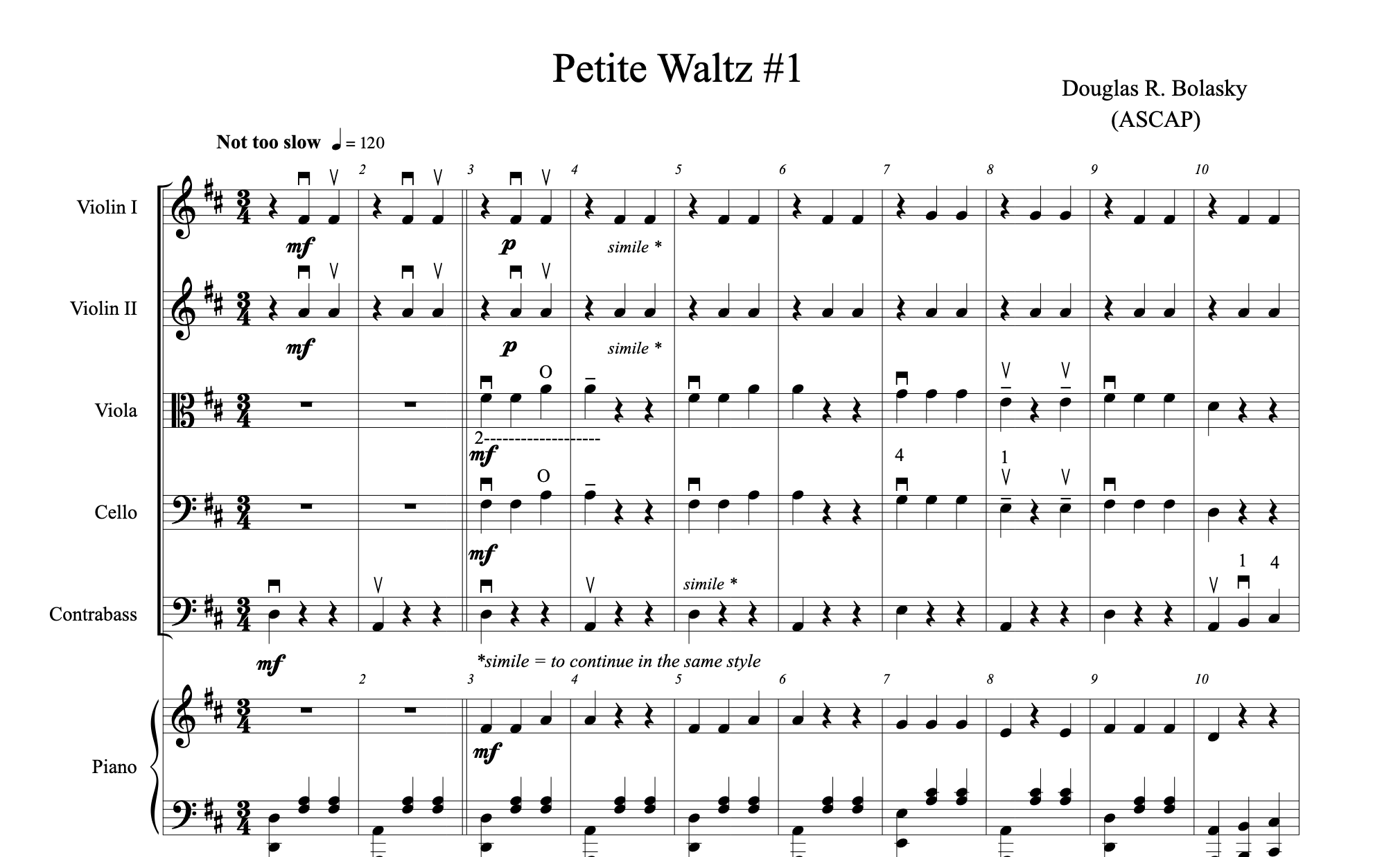
Petite Waltz #1
Key: D Major
Meter: Triple Simple (3/4). Using only the D & A strings, this piece serves as a very simple introduction to ¾ time using only quarter notes and quarter rests. It lends itself to being played arco, pizzicato, or any combination of the two. The conductor may also choose to introduce new bowing patterns to serve whatever purpose is at hand. Includes optional piano. Very easy. Use catalogue #SO-113D.
This same composition is offered in an edition transposed to G Major to employ the G & D strings. Like Petite Waltz #1 in D, this piece can help you accomplish all of the same goals while keeping your young orchestra on “familiar turf” where finger patterns are concerned. Includes optional piano. Very easy. Use catalogue #SO-113G.
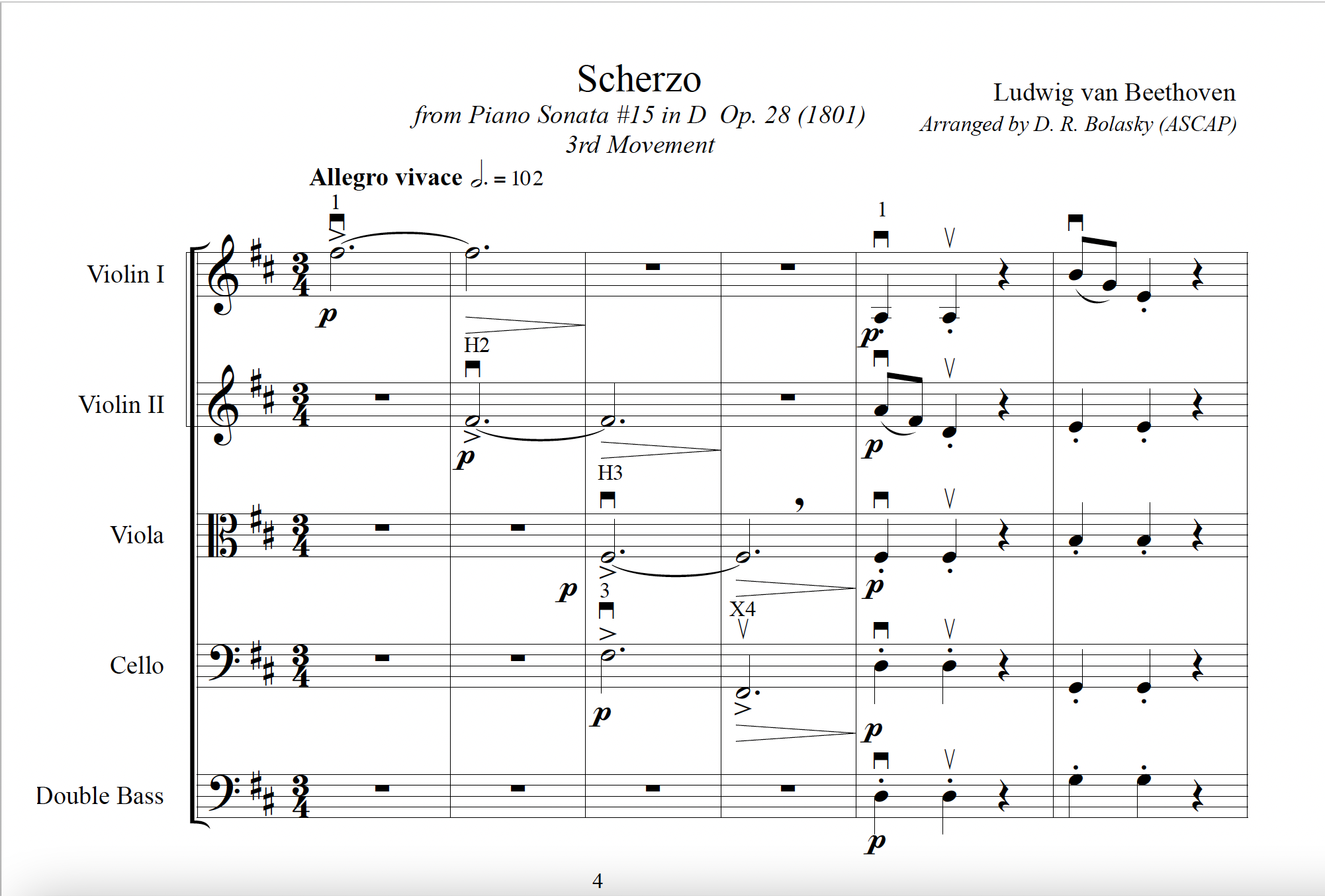
“Scherzo” from Piano Sonata #15, Op. 28
Key: D Major
Meter: Duple Compound (3/4). One of the true giants of both the orchestral and piano realms is Beethoven, so it is not surprising that much of his keyboard music lends itself well to the string orchestra. Challenge your orchestra to master the concept of the dotted half note as the unit of beat, now making the quarter note the subdivision! Melodic responsibilities are shared across the entire ensemble, and your students will also be introduced to some of the rarer chromatics (B#!) found in the arrangement of this work in the original key. Scherzo is playable by a string quartet using the included substitute viola & cello parts. Use catalogue #SO-124D.
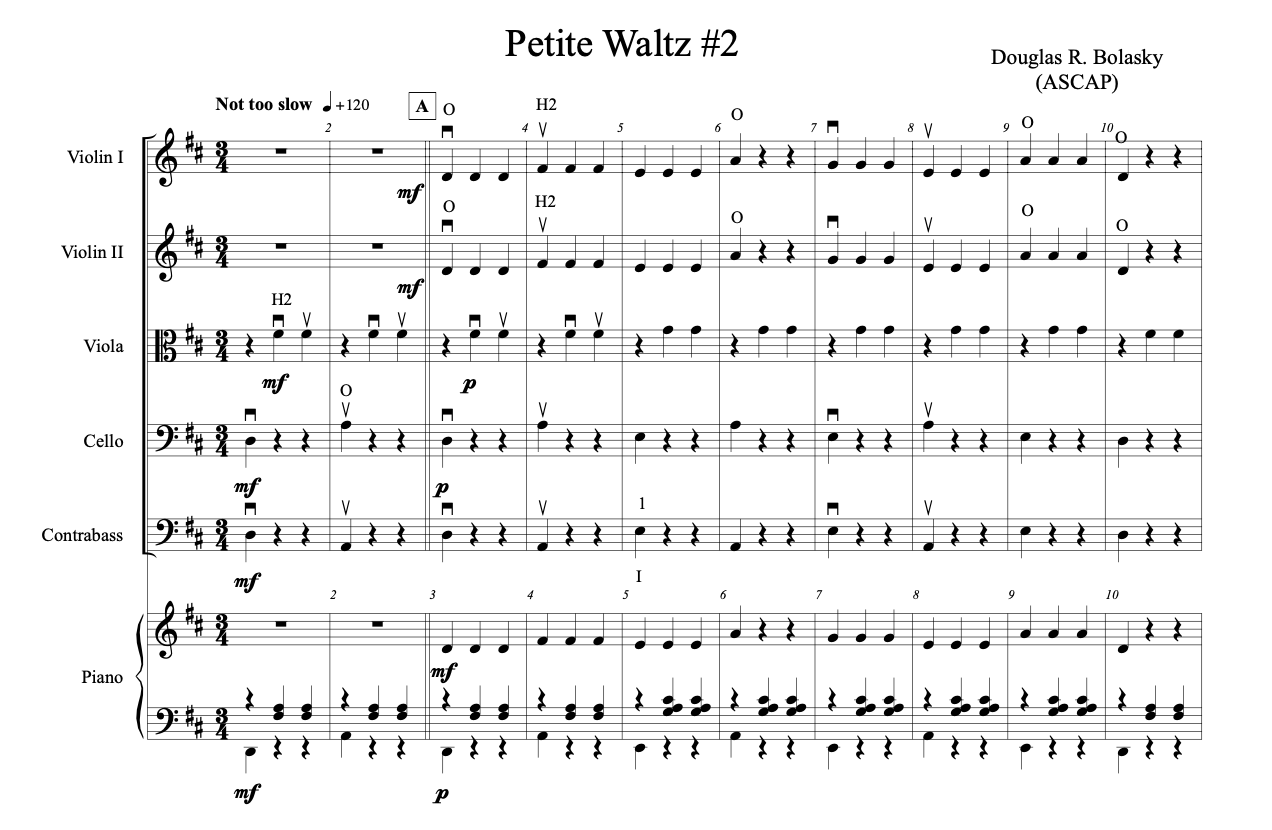
Petite Waltz #2
Key: D Major
Meter: Triple Simple (3/4). Like its companion piece “Petite Waltz #1,” “Petite Waltz #2 uses only the D & A strings. It serves the same purposes and is a great way to include a waltz on a concert program with minimal rhythmic challenges. Includes optional piano. Very easy. Use catalogue #SO-114D
Like Petite Waltz #1, Petite Waltz #2 is available transposed to G Major to employ the G & D strings while keeping the fingering patterns the same. Also like Petite Waltz #2 in D, it serves the same purposes and is a great way to include a waltz on a concert program with minimal rhythmic challenges. Includes optional piano. Very easy. Use catalogue #SO-114G.
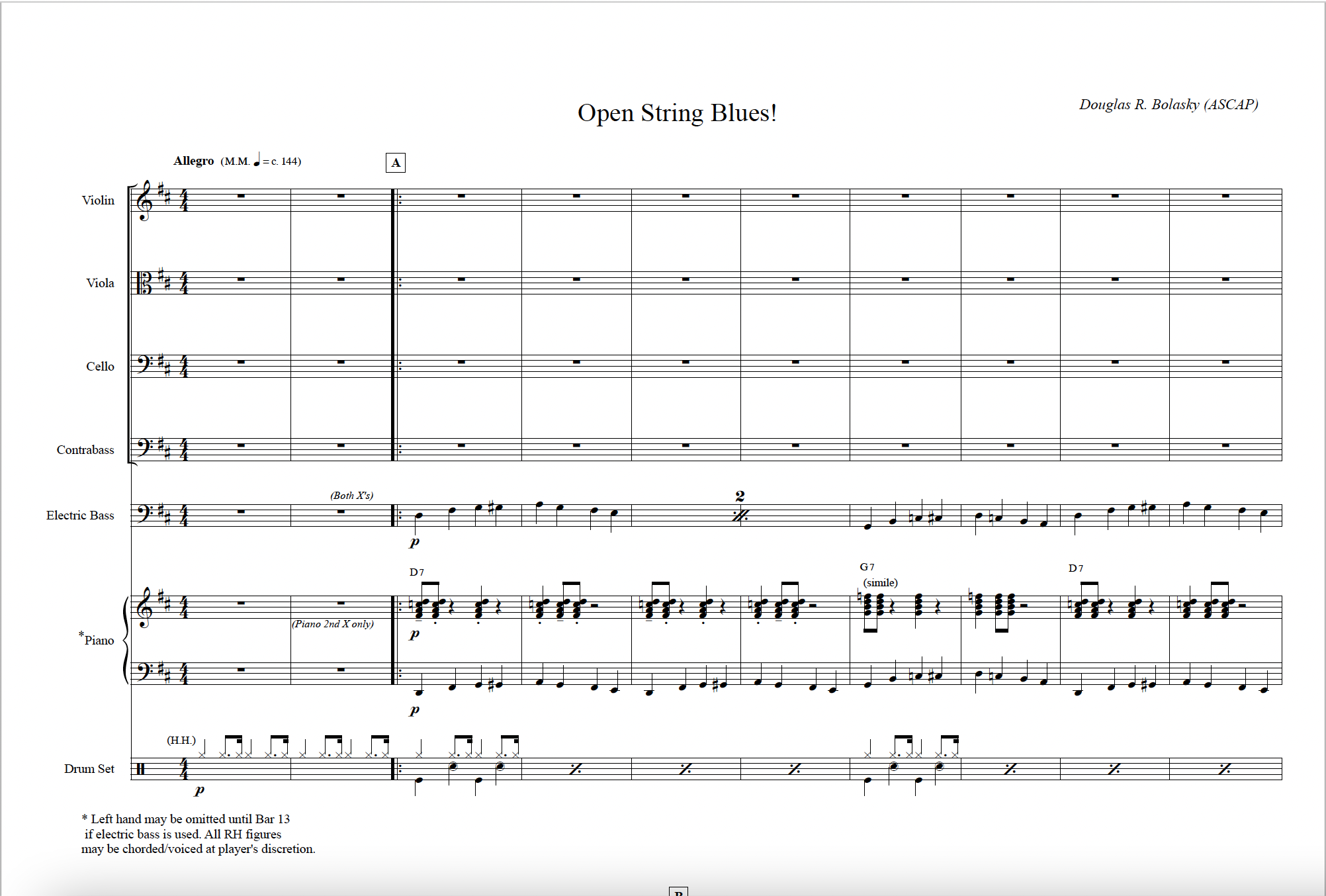
Open String Blues!
Key: D Major
Meter: Duple Simple (4/4). Get a few jazzers from your high school to sit in on trap set, bass, and piano and get ready for some fun times in your beginning string orchestra! With the exception of the Violin A part (which is not needed to perform this piece) Open String Blues! is playable entirely sans fingers. This is an easy introduction to 12-bar blues and provides an avenue to introduce double stops very early on. Play it “straight” or let your kids swing! Very easy.
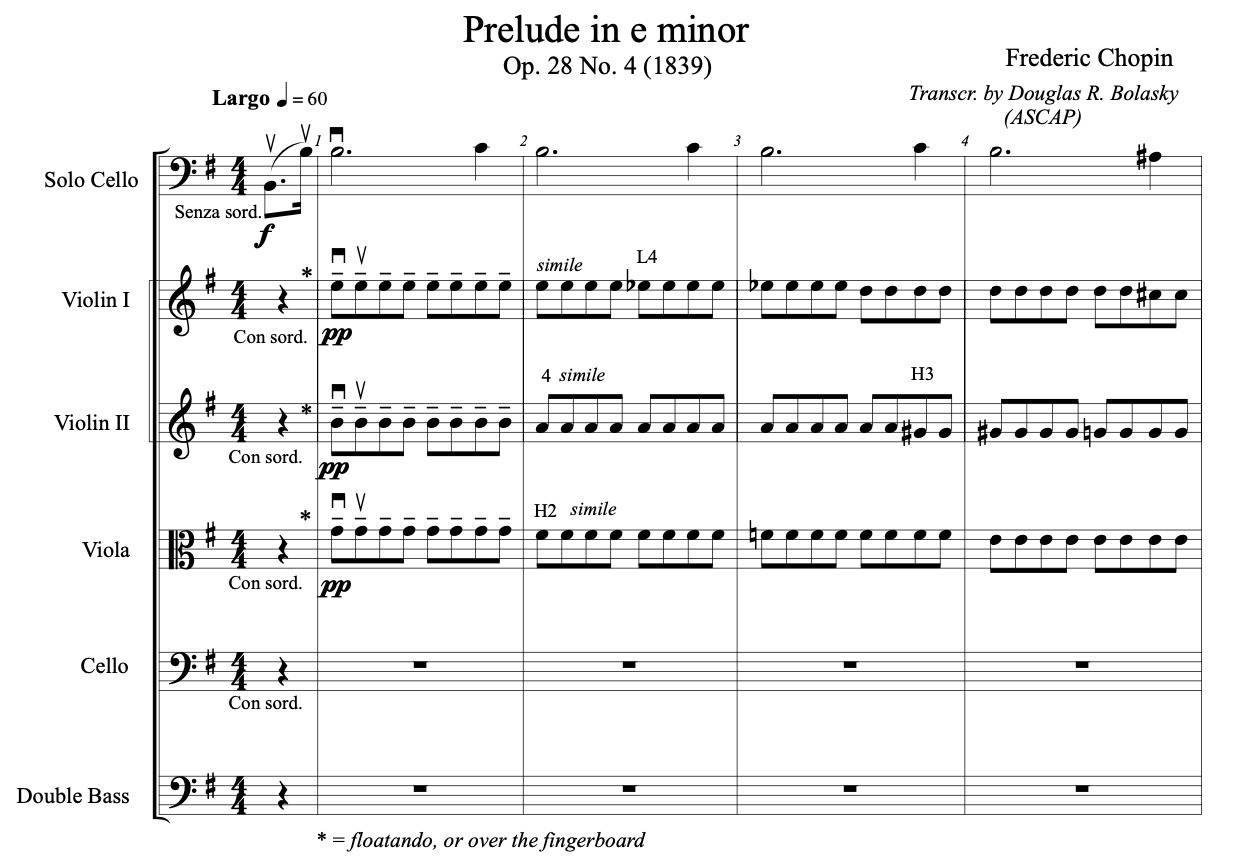
Prelude Op. 28 #3
Key: E Minor
Meter:
Duple Simple (4/4). This is a transcription of one of Chopin’s more well-known piano pieces. Scored for con sordino string orchestra, solo parts are included in order to feature your most accomplished violin, viola or cello student in the haunting and emotional melody. Transcribed in the original key, “Prelude” has few rhythmic difficulties for the orchestra, however your ensemble may be challenged by the chromatic nature of the piece plus the sensitivity and rubato that is demanded in music of this style and time. A live or recorded performance of the piano original will do well to further your orchestra’s understanding of this work. Orchestra – medium advanced. Solo parts – very advanced. Use catalogue #SO-115E.
Available also in the key of D Minor, thereby eliminating some of the chromatics found in the original key which may create pitch problems in younger orchestras. Even in the new key your ensemble may be challenged by the chromatics and rubato is still a necessary component. Orchestra – medium advanced. Solo parts – very advanced. Use catalogue #SO-115D.
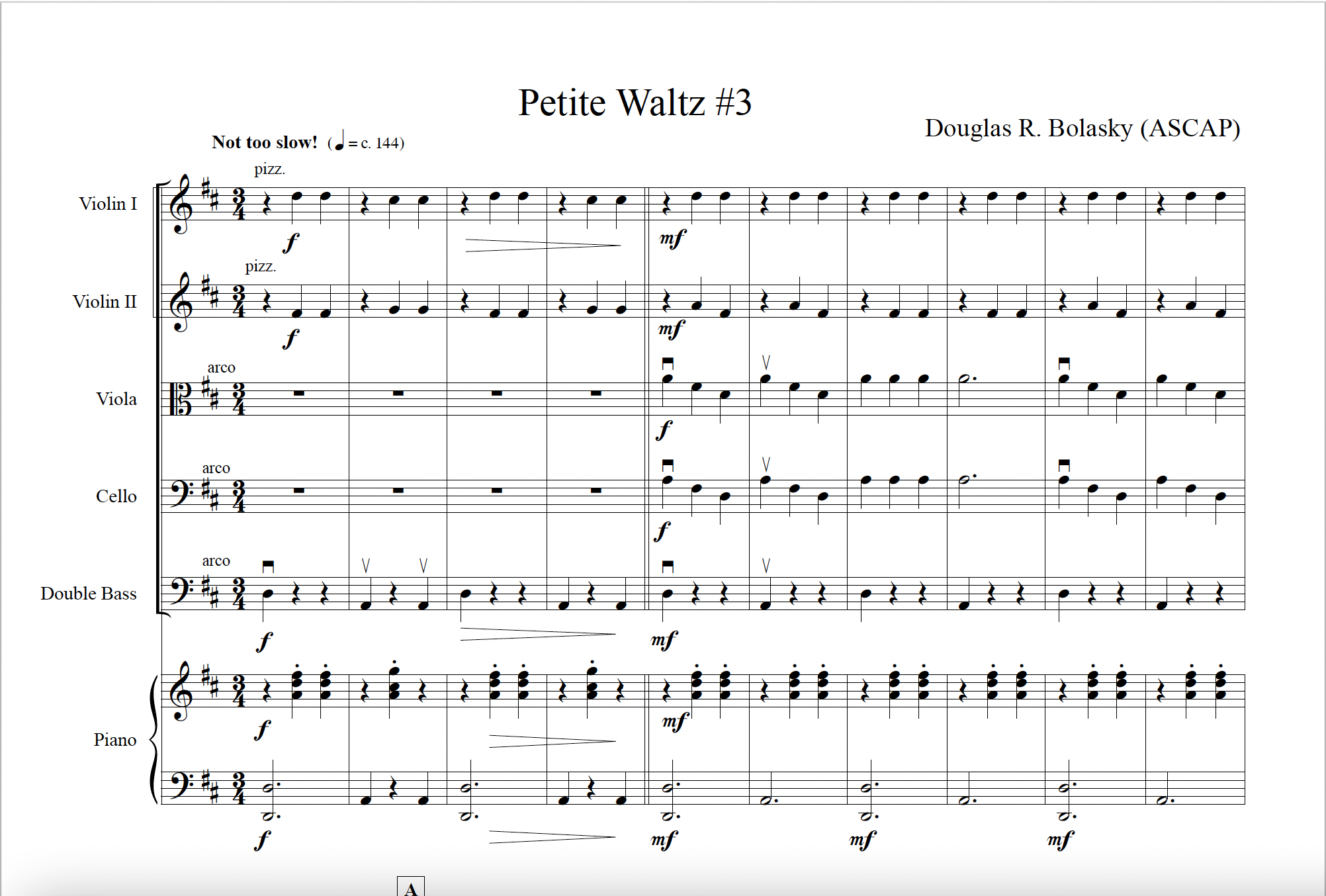
Petite Waltz #3
Key: D Major
Meter:
Triple Simple (3/4). If you want to find literature that takes your young orchestra into new tonal areas but is still accessible, then Petite Waltz #3 may be just the piece you need. Violas & cellos carry the melody in the A section against a pizz accompaniment in the violins. The contrasting B section features the violins arco in a canonic treatment of the new melody. Violas lead off the final phrase to bring the work to a close. Includes suggested fingerings and bowings. Easy – medium easy.
For D Major: Use catalogue #SO-122D
For C Major: Use catalogue #SO-122C
For G Major: Use catalogue #SO-122G
For F Major: Use catalogue #SO-122F
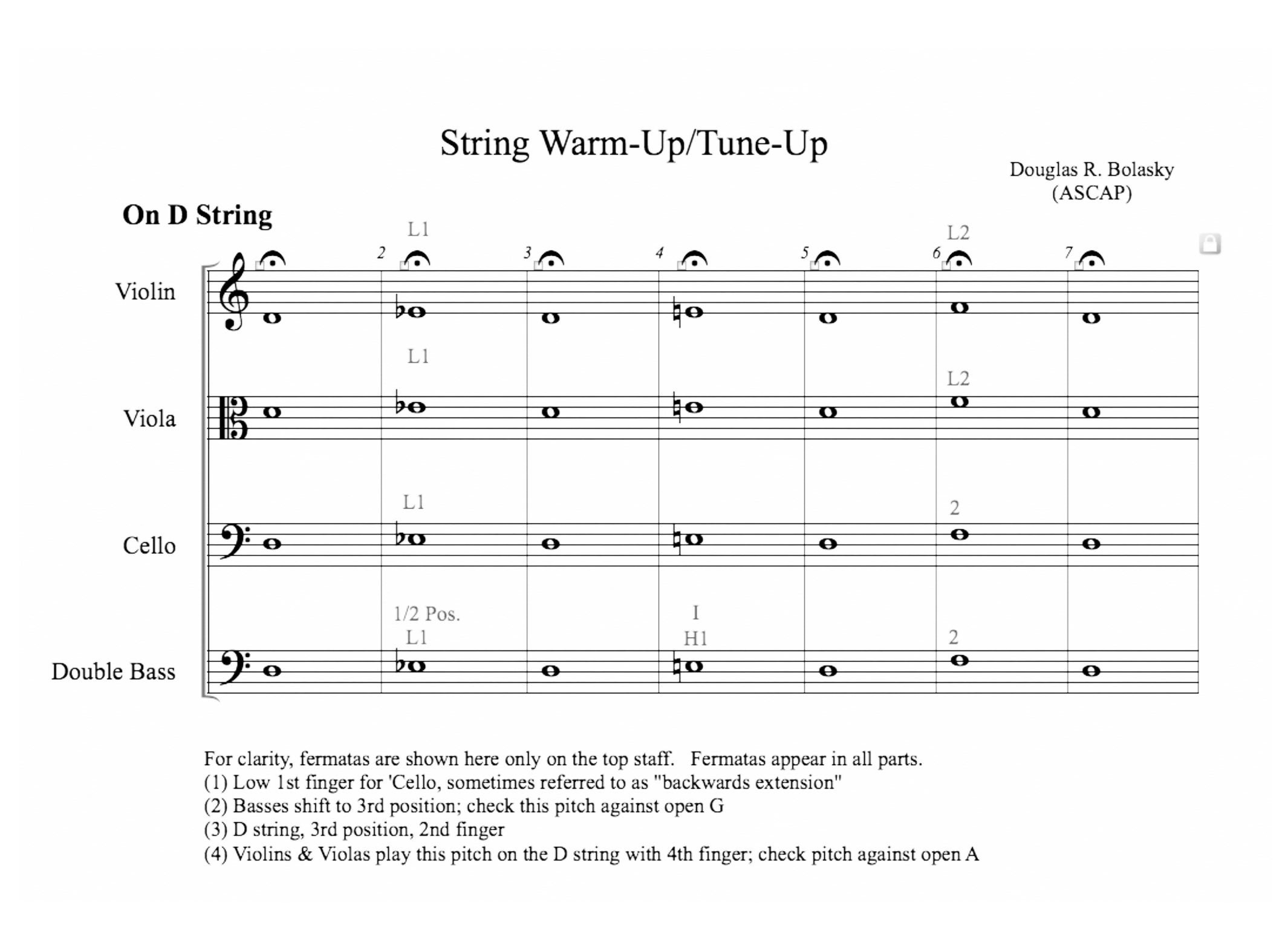
String Warm-up/Tune-Up
Key: None
Meter: None. This intonation study is derived from a similar unison exercise for concert band. Whereas the band version begins on an “open” pitch and progresses down by half steps, this string exercise begins on an open string (D, A or G) and progresses up by half steps. This is an excellent tool for developing a sense of pitch in your players while also keeping tabs on bowing technique and contact point on the string for a homogeneous sound. Opportunities exist for shifting and checking pitches against adjacent open strings. Comes with annotated score and parts. Suitable for intermediate level orchestras on up.
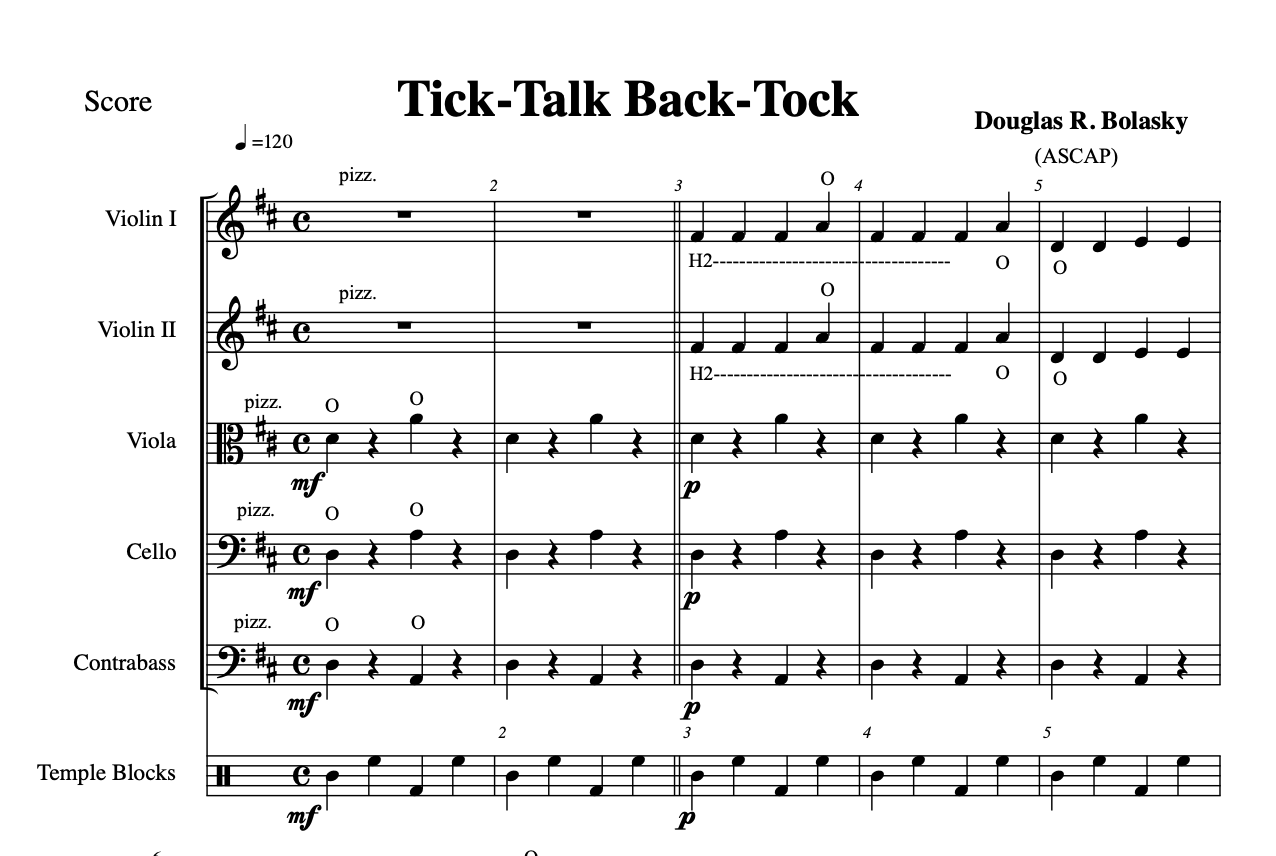
Tick-Talk Back-Tock
Key: D Major
Meter:
Duple Simple (4/4). This is the piece that started it all – written for a string teacher who was told there would be seven fewer weeks to prepare the beginning orchestra for their first concert than in past years! Pizzicato only (although you may choose to add arco), “Tick-Tock Back-Talk” incorporates a set of temple blocks to help keep the tempo steady for very young orchestras and provide rhythmic interaction with the strings – hence the title. Use an older or rhythmically reliable student for the temple blocks and the ending alarm bell effect. Includes optional piano. Very easy.
Now available in G Major! Same as the original ‘Tick-Talk Back-Talk’ except played on the G & D strings. Contact us at info@lvdmp.com for instructions to order the G Major edition.


